Growing mushrooms at home is highly rewarding, especially when the end result is delicious and unique fungi for the frying pan. A quick online search will show you tons of mushroom grow kits to choose between, from oyster mushrooms to pioppino mushrooms to lion’s mane. Growing mushrooms is a fun and fascinating hobby with lots of choices; it never gets boring. But, to get the most out of it and have amazing, successful harvests, there are some things you should know.
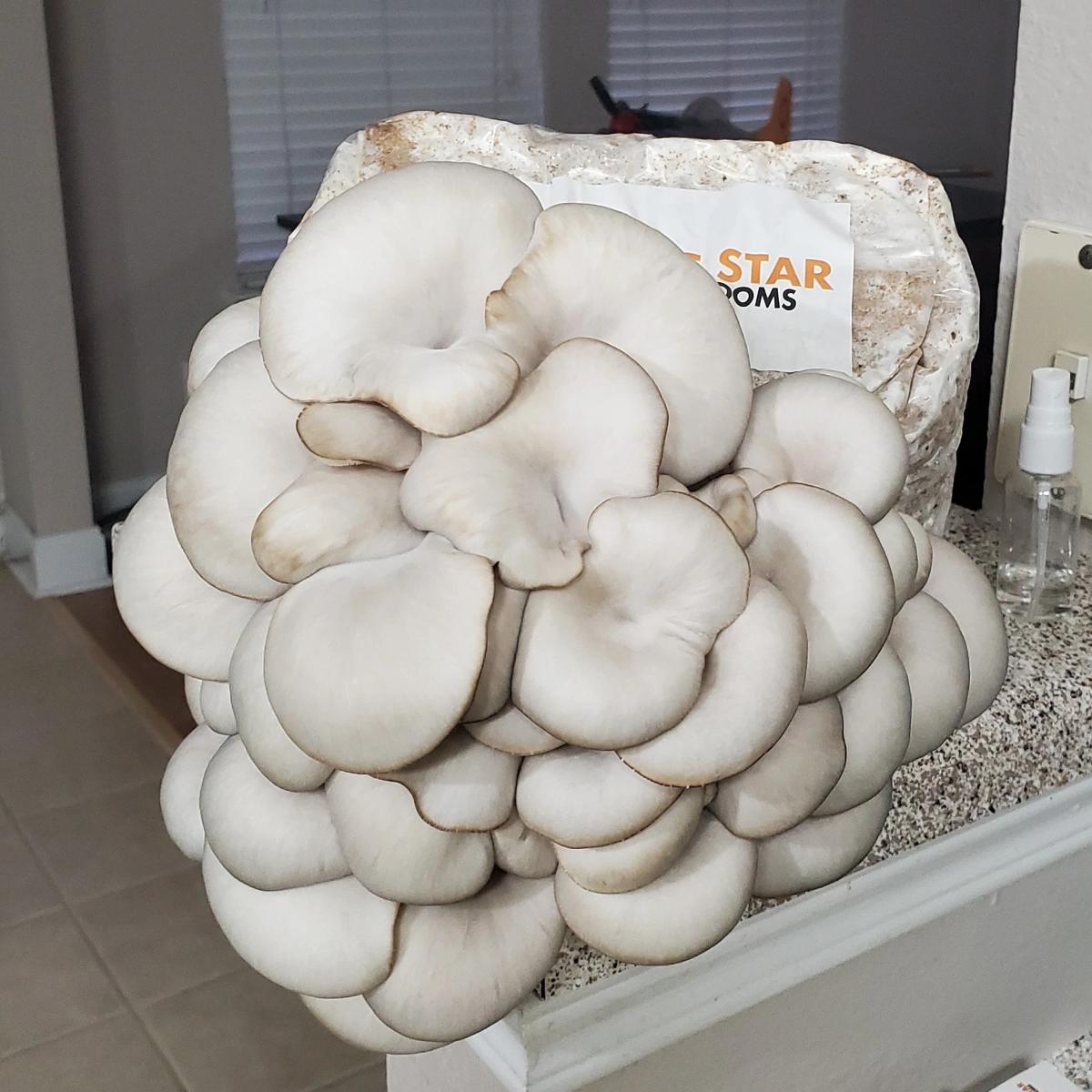
In addition to having so many different mushroom types to choose from, there are also different growing methods. How does one make sense of it all? So many new and unfamiliar mushrooms, each with it’s own set of instructions and needs. And it’s is awful when you put time into tending and cultivating, only to get a lacking harvest, or none at all. And sadly, this happens more than it should.
The biggest problem with mushroom grow kits isn’t their difficulty level. The main issue is that many are unreliable. And this is because there are many less than stellar sellers flooding the market. There are folks just in it to make a quick profit because mushroom grow kits are a new burgeoning market right now.

This list compiles the best and most reliable sellers across the country, so you’ll know which mushroom grow kits are worth the investment and will give you gorgeous mushrooms to harvest. We’d love to hear about other trustworthy mushroom grow kit sellers – let us know in the comments.
Jump to:
- The Different Types of Mushroom Grow Kits
- What Mushrooms Can I Grow From A Kit
- Mushroom Grow Kits: Indoors vs. Outdoors?
- Managing Expectations
- The Best Indoor Mushroom Grow Kits
- Easy Outdoor Mushroom Grow Kits
- Unique Mushroom Grow Kits
- Combination Mushroom Grow Kits
- The Five Things To Know Before Buying Mushroom Grow Kits
- The Basics Of Growing Mushrooms
- Common Questions About Mushroom Grow Kits
The Different Types of Mushroom Grow Kits
Mushroom Boxes & Blocks
A box or block mushroom kit is pre-filled with a growing medium and has the mushroom’s spores in it already. This is the simplest of mushroom grow kits. The different mushroom species have slightly different instructions, but mainly all you have to do is mist the block with water a few times a day and keep the environment humid.
With these kits, the mushrooms appear quickly, usually in 1-4 weeks. It is very satisfying and a quick way to have fresh, succulent mushrooms. These quick grow kits are a great first introduction to mushroom growing. They don’t take up much room and are meant to be grown indoors.

The downside to the mushroom box or block kits is that they only give one or two flushes of mushrooms. Once the mycelium is spent, the whole thing is tossed out. Other growing methods give continuous flushes and harvests, sometimes for many years.
Mushroom box and block kits are available for oyster mushrooms, shiitake, lion’s mane, chestnuts, button mushrooms, and pioppino.
Mushrooms on Logs
Growing mushrooms on logs is slightly more challenging but not too much. The biggest issue for many people is sourcing good logs to inoculate. It also requires that you have the outdoor space and preferred environment for the mushrooms.
To grow mushrooms on logs, you need to get spawn plugs. These plugs are already inoculated. You drill holes in the log, insert the plugs, and seal the holes.
The benefit of growing on logs versus a box or block kit is that the yields are higher. Plus, the logs are likely to produce for multiple years, giving you continuous harvests. The block grow kits produce one flush of mushrooms, possibly two, but aren’t designed to give mushrooms long-term.
Some mushrooms, like chicken of the woods and Maitake (hen of the woods), will only grow from plugs or sawdust spawn. Other mushrooms, like lion’s mane, shiitake, and oysters, grow very well from box kits or logs. These mushrooms are more versatile.
The downside of using plugs is that it may take 6-12 months to see any mushrooms. This is because the mycelium is working to spread throughout the log, and since they’re growing outdoors, their production is weather dependent. Growing mushrooms on logs is not for the impatient!
However, it is very rewarding even though you have to wait. It’s also less expensive than constantly buying the box or block kits.
Mushrooms on Sawdust
Sawdust spawn is inoculated spawn that is split up and spread outdoors or used to create fruiting blocks. Some mushrooms, like wine caps, almond agaricus, and blewits, will only grow using this method. For these three fungi, the inoculated sawdust is spread in a prepared garden spot. To grow them, you need a suitable outside location.
Using sawdust spawn for other mushroom species, like chicken of the woods, shiitake, and Maitake, is a less expensive option for larger grow operations. This is too much for the home grower who just wants some nice harvests once in a while.
The sawdust spawn is used just like the plugs and also requires the acquisition of logs for some species. However, it allows for greater production at a lower price for experienced growers.
Liquid Culture
Using liquid cultures to grow mushrooms is an advanced technique. This method involves creating sterile environments and substrates and doing the inoculation yourself. It’s not impossible; many home growers set up systems to grow using liquid cultures. However, if you’re new to mushroom growing, it takes time, patience, and lots of trial and error to get it right.
What Mushrooms Can I Grow From A Kit
There are many varieties available to cultivate using mushroom grow kits. Many you may have never had before – this is one of the reasons growing mushrooms from kits is so fun. It opens up the kitchen to new and delicious mushrooms.

Mushroom Varieties
- Oyster mushrooms (gray, white, king, pink, yellow, blue)
- King Trumpet Oyster
- Shiitake
- Lion’s Mane
- Button/Crimini/Portobello
- Almond mushroom
- Wine Caps
- Chestnuts
- Nameko
- Pioppino
- Cordyceps
Mushroom Grow Kits: Indoors vs. Outdoors?
Whether you grow mushrooms indoors or outdoors depends a lot on what you want to grow. Oysters, lion’s mane, shiitake, and button mushrooms can be grown indoors from pre-made block or boxed kits. Shiitake, oysters, and lion’s mane can also be grown outdoors, but not from quick-producing kits. Wine caps and almond agaricus must be grown outdoors.

Managing Expectations
Mushrooms are alive – they don’t always do what you want them to when you want them to do it. Like a tomato plant or apple tree, how they produce depends significantly on how you tend them. If you don’t do the regular misting or provide adequate humidity, you will not get good mushroom flushes.
All the companies listed below provide excellent instructions for their products (one of the top reasons they are featured here – easy-to-understand instructions are essential). However, as the grower, you must follow them in order for the blocks or spawn to produce.
Some specimens take longer to fruit than others; be sure you understand the timeline when purchasing.

The Best Indoor Mushroom Grow Kits
If you’re new to mushroom growing, you probably want to start with a basic kit. The mushroom box kits are the easiest.
This list of mushroom grow kits compiles the best who stand behind their kits and results across the country. It’s organized by the ease of growing and mushroom type, so you can easily find the best choices for you.
The Easiest Mushrooms To Grow
Oyster mushrooms
This is the most popular choice for home growers for two reasons. First, they’re the easiest mushroom to grow and very forgiving in less than ideal conditions. Second, many people have seen or eaten oyster mushrooms, so it’s a familiar choice. Oyster mushrooms are the best starter mushroom. This is especially true if you’re not overly familiar with mushrooms.
The oyster mushroom is an excellent edible species. It has a rich, mushroomy flavor that works well as a meat substitute as well as integrates easily into recipes. Oyster mushrooms come in a wide range of types – there are gray, white, yellow, pink, king trumpet, and even blue oyster varieties. And, each type of oyster has a unique taste — it’s not just their coloring that is different. You’ll have to try all the oysters side-by-side to see the subtle yet intriguing differences.
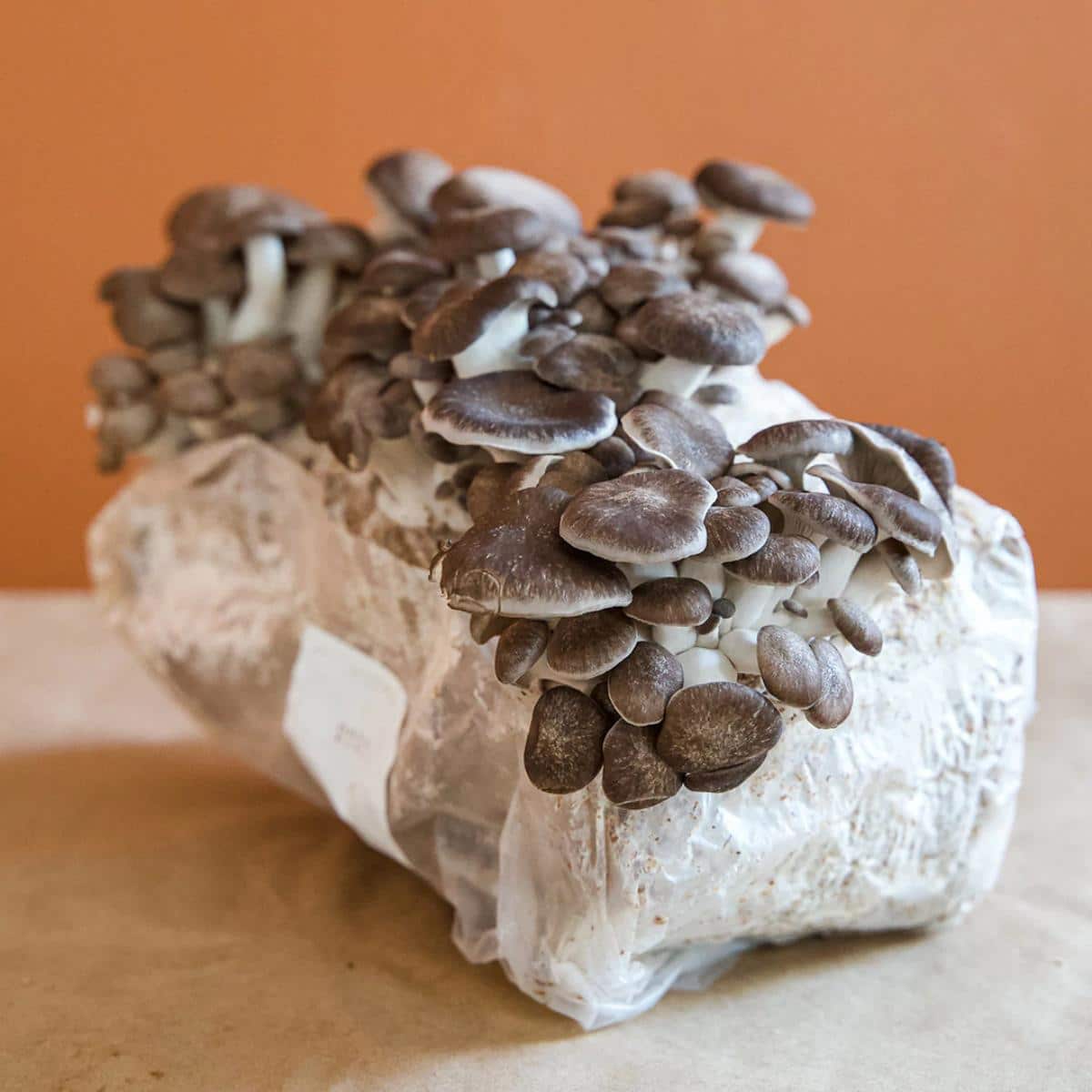
These oyster mushroom grow kits are indoor “tabletop” kits. They arrive as plastic-wrapped sawdust blocks that are already inoculated (combined with mushroom spawn) and just need to be activated. Activating usually includes cutting a hole in the bag, misting it daily with water, and providing a humid environment. Mushrooms are ready for harvest in 2-6 weeks.
- Pink Oyster Mushroom Kit from Forest Origins ($29.99)
- Gold Oyster Mushroom Grow Kit by Hernshaw Farms ($29.99)
- Blue Oyster Mushroom Grow Kit by Lone Star Mushrooms ($38)
- Yellow Oyster Mushroom Grow Kit by Far West Fungi ($25)
- Cosmic Queen Oyster Mushroom Grow Kit by Cascadia Mushrooms ($30)
- King Oyster Mushroom Kit by Root Mushroom ($25.99)
Many of these companies also sell oyster mushroom spawn or plugs, which can be used to grow oyster mushrooms outdoors. If you’re ready for more of a challenge, check out the options from Northspore, Field & Forest, and Cascadia Mushrooms.
Button Mushrooms (also known as cremini and portobello)
Cremini, portobello, and button mushrooms are actually all the same species. The white and brown cremini buttons are immature specimens. A portobello is a fully matured button mushroom.

Button mushrooms grow on compost. The button mushroom grow kits include the growing substrate, which is already inoculated. All you have to do is water the box as directed and put it in a cool, dark location. Soon, you’ll be enjoying the freshest button mushrooms possible!
- Baby Bella Portabella Mushroom Growing Kit by Willow Mountain ($29.95)
- White Button Mushroom Fruiting Kit by Mushroom Mountain ($28)
- Crimini Baby Bella Mushroom Growing Kit by Mushroom Adventures, certified organic ($39.95)
Lion’s Mane
The lion’s mane mushroom is quickly becoming the star attraction at many fine-dining restaurants. Its meaty texture and curious similarity to crabmeat are hard to resist. Lion’s mane is also super fun to grow because it is incredibly unique looking. Anyone who visits when you have this mushroom fruiting will be astounded – it looks like a weird head of cauliflower or alien brains emerging from a block.
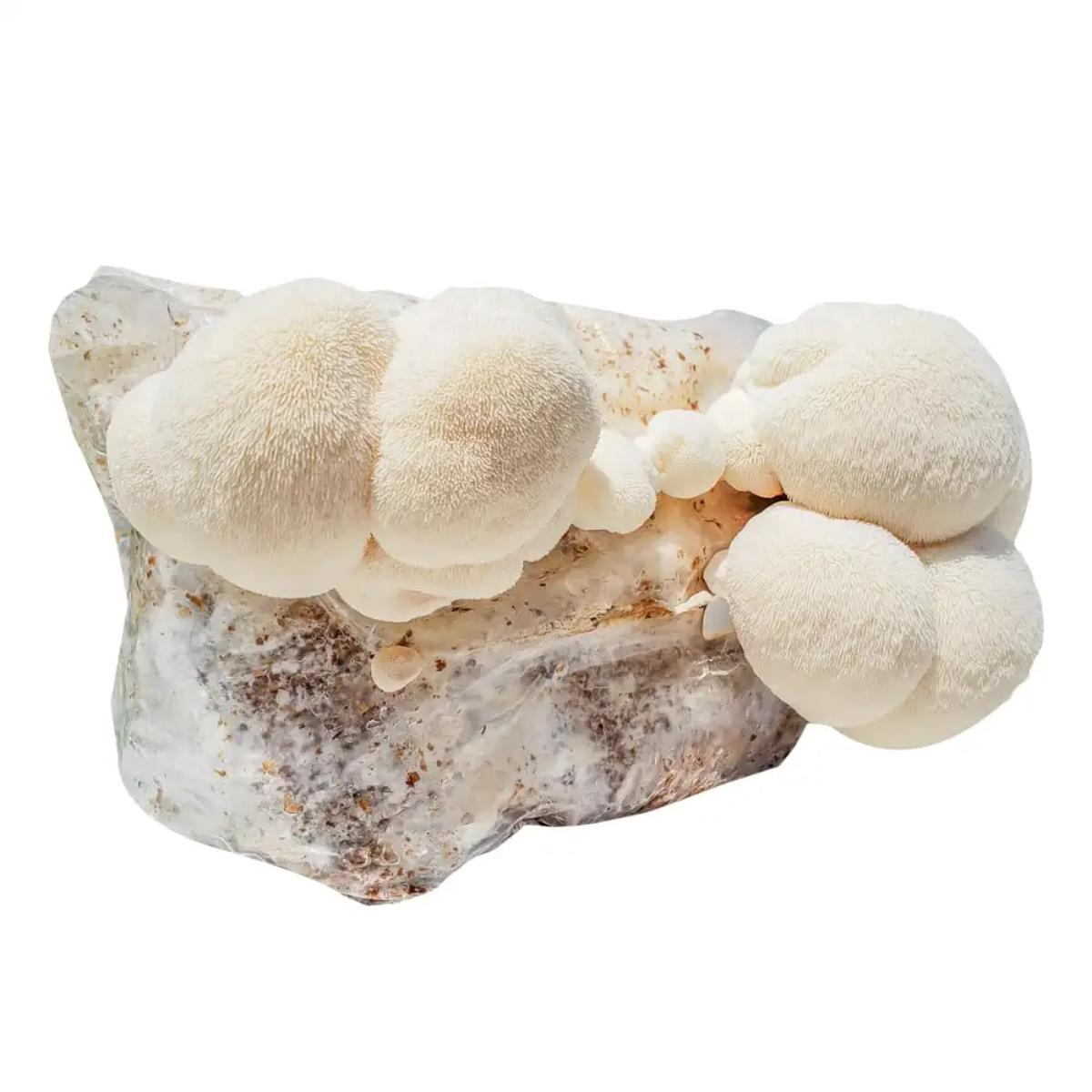
This mushroom is an excellent meat substitute because of its distinct flavor and dense texture. Lion’s mane retains its shape during cooking and can be grilled, sauteed, roasted, and made into faux crab cakes.
- Organic Lion’s Mane Mushroom Growing Kit by Myctyson Mushrooms ($28)
- Lion’s Mane Mushroom Grow Kit by Lone Star Mushrooms ($34.95)
- Lion’s Mane Growing Kit by Root Mushroom ($26.99)
- Grow Your Own Lion’s Mane Mushroom Kit by Michigan Mushroom Company ($24.99)
Reishi
The infamous reishi mushroom of traditional Chinese mushroom is easy to grow at home. Most people grow it to harvest the mature brackets – this is not a culinary mushroom. Mature reishi is a hard, shelf fungus that you cannot cook up and serve at the dinner table.
To use this mushroom, break up the reishi brackets for powder and tea. It can also be used to infuse soup stocks or broth.
However, young reishi tips – just the white parts – are edible when very young. They are still moist and tender at that time and wonderful pan-fried. Avoid the yellow band of flesh as that is usually quite bitter.
Reishi mushrooms are quite spectacular-looking. In the wild, they form broad brackets on hemlock trees. The top of this shelf fungus is a rich, shiny, waxy burgundy red, while the undersides are creamy white. The reishi from a grow kit won’t be nearly as large and usually grow long, skinny, and jutted, like reindeer antlers.
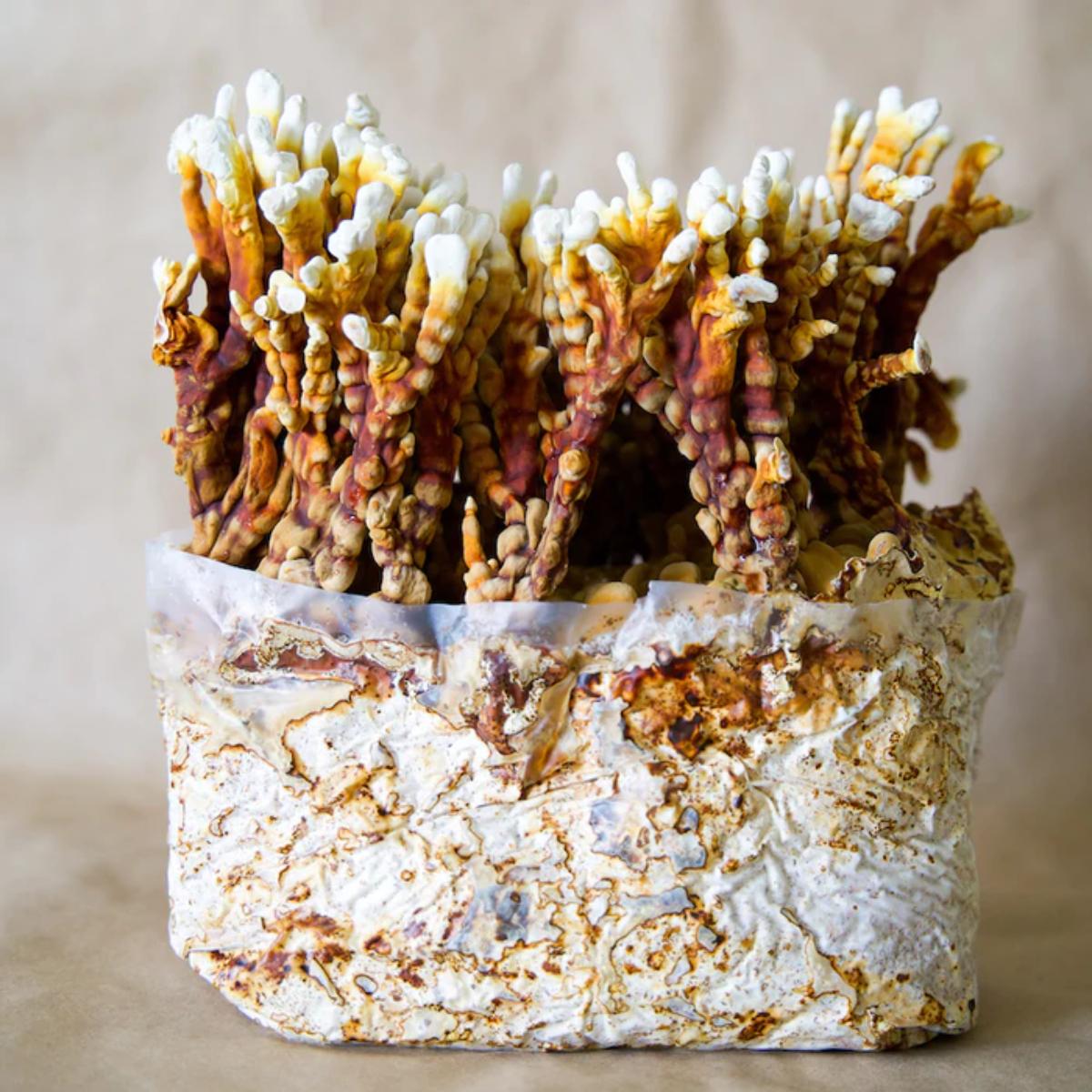
Reishi is made into tea or tinctures to boost the immune system, treat lung issues, reduce stress, and as an adjunct treatment with chemotherapy and radiation.
The reishi mushroom is a slow grower – the grow kits take 2-3 months to produce mature specimens. This is a grow kit that takes a bit of patience.
- Reishi Mushroom Grow Kit by Hernshaw Farms
- Grow Your Own Reishi Mushroom Kit by Michigan Mushroom Company ($22.99)
Intermediate Mushroom Grow Kits
Shiitake
A mushroom well-known for its delicious flavor and potent medicinal properties, Shiitakes are also fun to grow. They’re the second-most cultivated mushroom after button mushrooms and are excellent added to stews, ramen, pasta, stirfries, or just sauteed. Shiitake mushrooms taste earthy, meaty, and rich.
- Shiitake Ready To Fruit Block by Trailbridge Farms ($22)
- Shiitake Mushroom Mini Farm by Root Mushroom ($24.99)
- Shiitake Mushroom Growing Kit by SnoValley ($32)

Chestnut Mushrooms
This is a beautiful mushroom with dark orange-brown caps and shaggy white scaling. The Chestnut mushroom has a nutty, woodsy flavor with a slightly crunchy texture – the texture is akin to al dente asparagus. Some say chestnuts taste like a mild Shiitake mushroom.
Chestnut mushrooms are hugely popular in Japan. They add robust flavor to any dish and are commonly used in soups, stirfries, and pasta. Chestnut mushrooms grow in dense clusters; you’ll have plenty to cook and experiment with from a home kit.

Chestnut mushroom kits are a little more involved than oysters or lion’s mane. Typically, they’re a bit pickier about their growing environment, and they usually take longer to pin and fruit.
- Chestnut Table Top Farm by Field & Forest ($24)
- Chestnut Mushroom Ready-to-Grow Fruiting Block Kit by North Spore ($30)
Brown Beech
Brown beech mushrooms grow on beech trees in the wild. They’re also known as brown clamshell mushrooms or Buna Shimeji. Brown beech is well-known in Asia but only starting to become familiar in North America as more people discover its distinct and excellent flavor.

The brown beech mushrooms are small with brown caps and slender white stems. They grow in dense clusters from a central base. Brown beeches taste a little nutty, slightly sweet, and earthy, and they have a nice crunchy texture when lightly cooked. They’re excellent in ramen, noodle dishes, soups, added to pizza, lightly grilled, or very simply sauteed.
- Brown Beech Mushroom Grow Kit by MycoLabs ($27.99)
Advanced Mushroom Grow Kits
Pioppino
Pioppino (or Pioppini) is a specialty mushroom that has been popular in Asia for centuries but is only just making it to North American tables. It is also known as the black poplar mushroom or velvet pioppino.

Pioppino caps are light or dark brown, depending on the growing conditions. They grow in clusters on long, slender stems. Their flavor is rich, mildly nutty, earthy, and very lightly peppery. When cooked, the cap and stem develop a nice crunchy texture. Pioppino mushrooms are exquisite added to risotto, pasta dishes, broth soups, hot pots, and stirfries.
- Pioppino Mushroom Cultivation Kit by Fungi Ally ($32)
- Pioppini Table Top Farm by Field & Forest ($24)
- Pioppino Mushroom Ready-to-Grow Fruiting Block Kit by North Spore ($30)
Nameko
The deep butterscotch brown of Nameko mushrooms gives a hint to their taste – a cross between earthy, lightly fruity, slightly nutty, and a little sweet. Namekos are related to pioppino mushrooms; they’re in the same family and grow very similarly.

Nameko caps and stems are brown, and the caps are covered with a gelatinous substance that makes them very shiny. The gelatinous coating disappears with cooking, so if that’s unappealing to you, don’t worry. Like pioppinos, nameko mushrooms are very popular in Asia but virtually unknown in North America.
Growing these mushrooms is likely the only way you’ll be able to try them fresh. Nameko mushrooms are ideal for soups, miso, stirfries, pizza topping, grilling, and sauteing.
- Nameko Mushroom Ready-to-Grow Fruiting Block Kit by North Spore ($30)
Cordyceps
Considering cordyceps cultivation is still a new process (at least in North America), it is remarkable to see it as a home grow kit. This one takes patience and may not be the most reliable, but it’s fun to watch. Cordyceps aren’t culinary mushrooms in the traditional sense – they’re usually ground up and made into a tea or tincture.

Cordyceps fungi are renowned for their positive effects on athletic performance, fatigue, and overall energy-boosting properties. This kit doesn’t grow a lot of cordyceps, and it takes 2-5 months, but it’s very cool to watch for the orange spindly mushroom fingers.
- Cordyceps Militaris Growing Kit by Root Mushroom ($28.99)
Easy Outdoor Mushroom Grow Kits
These two mushroom species are super easy to cultivate if you have some outdoor space. These aren’t grow kits like the other mushrooms. When you order, you get a bag filled with sawdust inoculated with mushroom spawn. Then, you spread the inoculated sawdust in a prepared bed.
The great thing about these two options is that you don’t have to do much once you plant the bed. Mother Nature takes care of most of the fungi’s needs. You may need to pay more attention during dry spells, but that’s it. In this way, they are even easier than indoor mushroom grow kits.
Wine Caps
If you have a 5×5 slightly shaded location in your yard, you can grow wine caps. They’re the absolute easiest beginner mushroom for outdoor growth. Wine caps grow on wood chips or straw and just need a well-balanced bed prepared for them – it’s pretty easy to do.
Besides being super easy to grow, wine caps are delicious. And they’re huge. Wine caps easily get to be bigger than a portobello, and they have a light nutty, crisp flavor. They are wonderful grilled, sauteed, stirfried, and roasted. Any way you use a portobello, you can substitute wine caps. And, if you grow these, you’ll have plenty to experiment with – they are prolific producers once they get going.
Wine caps can take 6-12 months to produce, depending on when you inoculate the wood chips. Then, they should provide abundant harvests for several years at least. As a bonus, they’re natural soil builders and provide fantastic benefits to the garden.
- Wine Cap Mammoth by Fungi Ally ($25)
- Wine Cap Stropharia Garden Starter by Cascadia Mushrooms ($30)
Almond Agaricus
Almond Agaricus is a close cousin to the button mushroom but with a much richer flavor and an intoxicating scent. They’re called almond agaricus for a reason – they smell like almond extract. Most of the scent disappears in cooking, but they’re still a delight to the tastebuds.
This mushroom grows on compost and likes lots of warmth. It isn’t complicated to grow, but it does have pretty specific needs, including temperature and humidity. Many people grow almond agaricus in their greenhouse or high tunnel in cooler climates. Warm weather locations may get yearly flushes, but the mycelium doesn’t survive any freezing temperatures.

Even though you may only get one year of mushrooms, it’s worth it for the taste and smell of this unique species. Almond agaricus is not something you can usually get in stores. But, funnily enough, it was the mushroom choice for cultivation before the “now” common button mushroom (Agaricus bisporus).
- Almond Agaricus Sawdust Spawn by Field & Forest ($25)
- Almond Agaricus Mushroom Sawdust Spawn by Northspore ($25)
Unique Mushroom Grow Kits
- Classroom Activity Kit by Mushroom Mountain ($40) – A fun mushroom growing kit with materials to make 20 mini oyster mushroom farms.
- Coffee Cultivator by Mushroom Mountain ($15) – These mushroom grow kits include a starter culture to grow oyster mushrooms from your spent coffee grounds.
- Craft Mushroom Grow Kits by Far West Fungi ($7) – With this kit, you can watch oyster mushroom mycelium break down newspaper and produce mushrooms. Very neat!
- Oyster TeePee Kit by Field and Forest ($27) – These super fun mushroom grow kits are great for kids — grow oyster mushrooms from a roll of toilet paper!
Combination Mushroom Grow Kits

It’s hard to decide which mushroom grow kits to start with from all these choices. Many companies offer combo kits and, even more fun, mystery combo kits. This is a great way to explore different mushroom species to see which ones you like best to grow and eat.
- Lion’s Mane and Pink Oyster Mushroom Grow Kit Bundle by Lone Star Mushrooms ($68)
- Specialty Trio Mushroom Grow Kit (pink, white, and brown oysters) by Forest Origins ($90)
- Mystery Mushroom Grow Kit by Hernshaw Farms ($29.99)
- Variety Pack Ready To Fruit Organic Shiitake and Oyster Mushroom Grow Blocks by Trailbridge Farms ($37)
- Grow Kit of the Month by Nearby Naturals ($40/mo)- a new kit every month
The Five Things To Know Before Buying Mushroom Grow Kits
- Many kits are time-sensitive – they cannot be stored at room temperature for even a few days, or they start fruiting. Only order the mushroom grow kits when you have the time to commit to tending them immediately or plan on refrigerating the kit. But also, some kits can’t be refrigerated, either. So, it’s up to you to know what you’re getting and what you need to do.
- The kits take time to fruit mushrooms. For some, it’s 2-4 weeks; for others, it’s 2-5 months. Again, this takes some planning, or your kits won’t produce mushrooms.
- The mushroom kits will need watering or misting every day or almost every day. It’s like a tomato plant; it needs regular attention. If you skip days or forget, it’s usually okay once, but not long-term.
- Read the instructions. Seriously, don’t skip this.
- If you have any questions about the kits, contact the sellers. They should respond readily and informatively. If they don’t, it’s probably best to choose a different company. Each company develops its kits differently, and the instructions will vary on type and production. There is no one all-purpose answer to what is needed to grow mushrooms. It will vary from company to company, so you need to ask specifically from the one you’re ordering the mushroom grow kits.
- Again, think of mushroom cultivation as vegetable growing. Peas, pumpkins, and tomatoes have vastly different temperature, light, and climate needs. If you tried to grow them all the same way, they’d fail. Each mushroom species is like this, with its own preferred growing climate and needs.

The Basics Of Growing Mushrooms
Fungi require three basic things to thrive: moisture, a bit of light, and a rich growing medium with plentiful nutrients. Some mushrooms grow on logs and wood chips, while others prefer compost, straw, or sawdust. There is no one way to grow mushrooms, as each species tends to have a preference for a growing medium.
To be successful, you need to replicate as close as possible the preferred growing climate. This may mean setting up a small humidity tent (there are easy ways to do it for these small kits using a plastic bag) or keeping the mushrooms in a dark closet.

Common Questions About Mushroom Grow Kits
Can you grow morel mushrooms from seed or spawn?
Maybe. There are many companies selling morel “seeds” with guaranteed results. I’d stay far, far away from them. Morels are incredibly tricky to grow; tons of commercial growers would be doing it if it were easy.
That being said, it is possible. However, it might take 5 years, or 10 years or 15 for any morels to pop up, if they do at all. Morel growing is experimental at best. They require a climate with seasonal changes, including freezing weather. They also will only grow with specific trees, so you must have those around to inoculate or wood chips of those species.
Because morel mushrooms are so valued, many sellers are offering them and making a profit from people’s inexperience. Morel seed (spawn) is the snake oil of the mushroom-growing world. The only place I’d trust to buy morel spawn is from North Spore, which makes it very clear in their description that it is experimental.
Hopefully, this will change in the future. For now, you can buy the spawn but go into it knowing results, if any at all, may be very limited, and it will take many years.
What about growing chicken of the woods and Maitake?
Chicken of the woods and Maitake (hen of the woods) will only grow outdoors – there are no easy kits for these mushroom species. They can be cultivated, and if you have the space and the ideal climate, you should go for it. However, these aren’t the best place to start for the beginner. Check out Northspore or Field & Forest for sawdust spawn or plugs.
How much can I harvest from mushroom grow kits?
This depends entirely on the mushroom grow kit and the company – there should be information provided by the seller indicating the expected yields. In most cases, you can expect to harvest several pounds of mushrooms.








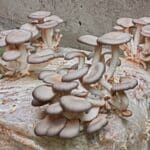

Gary Smidutz
Thank you for the information I will definitely be ordering my 1st kit! Any suggestions I am leaning towards portobellos.
Jenny
All of them LOL. Button/portabellos are easy if you have a dark space for them — they’re basement, dark closet, or garage dwelling mushrooms. Oyster and lion’s mane are ones that you can grow on your countertop — they need a bit of light. Personally, I like the more unique ones that you can’t get in the grocery store. I think you’ll be happy with any, though!